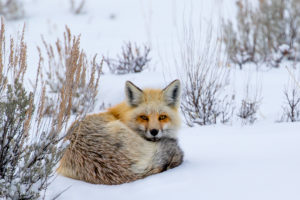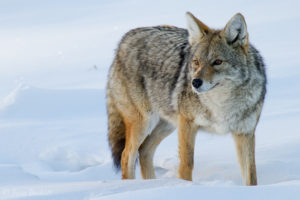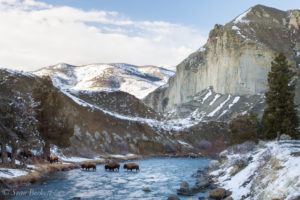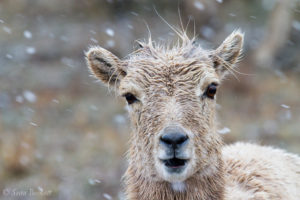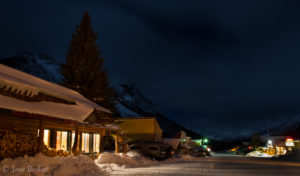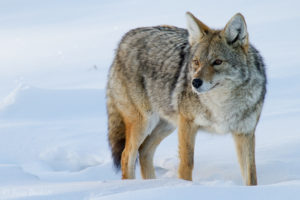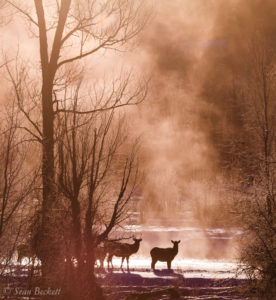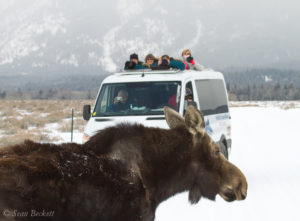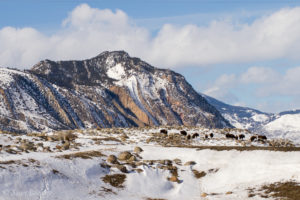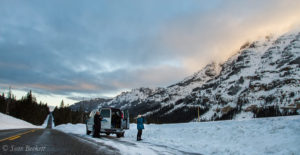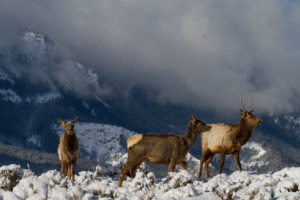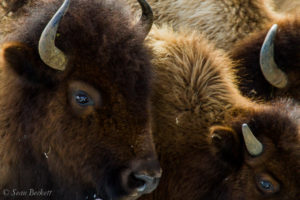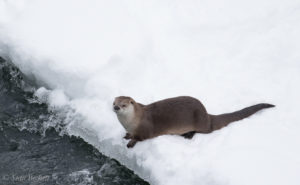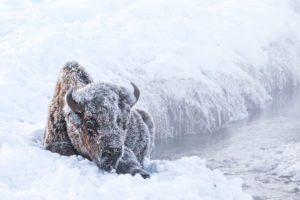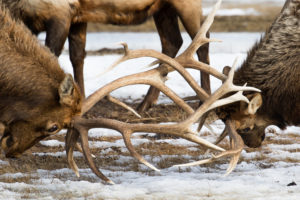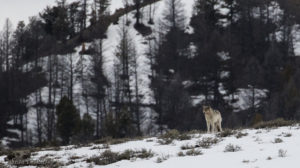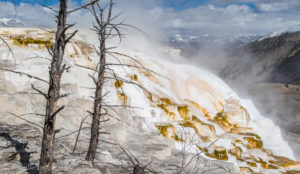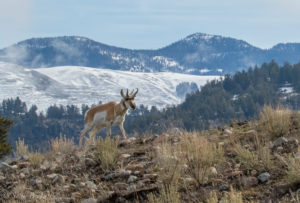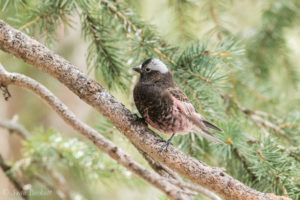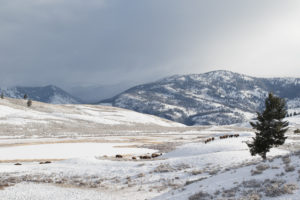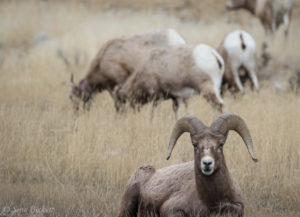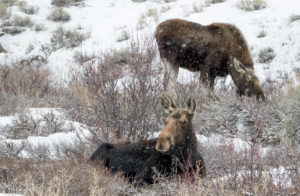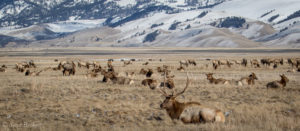Winter in Yellowstone

March 7 - 12, 2020
$3,275 | ($500 deposit due upon registration)
8 participants max
A
single, frosty bison exhales ribbons of steam that glow in the golden sunrise over Yellowstone’s Northern Range. Bighorn sheep feed quietly in the massive, volcanic cliffs and ridgelines above us, while steam vents billow from a nearby hillside. On snowshoes, we follow fox and coyote tracks to a spectacular promontory overlooking an unending expanse of valleys, mountains, and river bottoms. From here, we train our spotting scopes on a distant family of wolves perched on a knoll next to a fallen bull elk.
Exploring Yellowstone during its least-visited time of year, we’ll explore the park among an astonishing array of wildlife. On this week-long, small group safari into the heart of the wild, find out why the 18-million-acre Greater Yellow Ecosystem has been hailed as "America's Serengeti," "The World's Wonderland," and "The Land of Fire and Ice.”
This itinerary focuses on Yellowstone’s 75-mile long series of canyons and valleys known as the Northern Range: the area of greatest big game wildlife abundance and diversity in the entire lower 48. Each day will be spent on morning and evening wildlife safaris based out of the warmth and safety of a comfortable vehicle customized for winter wildlife watching in Yellowstone. In the afternoons, we’ll hike or snowshoe to gorgeous waterfalls, scenic vistas, hot spring terraces, wildlife watching vantage points, abandoned wolf dens, and more.
This itinerary is designed for maximum flexibility to tailor each day’s journey to the whereabouts of wildlife, the interests of the group, and the region’s variable weather. The itinerary below is an example of a typical week.
Additional Information
Physical Requirements: Much of the trip is vehicle-based, but participants should expect to hike or snowshoe 2-3 miles daily on terrain with flat to moderate inclines. This trip ranges in elevation from 4,000 to 7,500 ft.
Travelers should be comfortable with early mornings. We will generally depart our lodging at or before sunrise and be active until after sunset. In some cases, we will return to our lodges for small mid-day siestas, but this is not always possible due to the distance of locations we travel between.
Climate: Yellowstone in winter is one of the most spectacular yet extreme climates on the continent. Temperatures may range from -20F to +50F, though daily high temperatures are generally in the 20s to 40s above zero. Warm winter boots and a thick winter parka are must-haves.
Health Considerations: This itinerary takes place between 4,000 and 8,000 feet above sea level. While this altitude is rarely hazardous, participants with a history of altitude sickness or other altitude-related conditions should consult their physician for precautions. Dehydration and sun exposure are common issues in the arid Rocky Mountains. Please come prepared to drink plenty of fluids and wear sunscreen. There are no vaccines or other travel-related medications that are typically administered for domestic travel to this destination. Tap water is safe to drink throughout the trip.
Transportation: The land transportation will be done in a 12- to 15-passenger van customized for wildlife viewing. We have limited the maximum capacity of this trip to 8 participants to allow for more space and comfort in the vans.
Wildlife: While we make every effort to spend each day seeking the most incredible wildlife viewing opportunities that the Greater Yellowstone Ecosystem offers, there is no guarantee of seeing particular species. Wildlife is capricious and unpredictable, and though your trip leader knows where to find areas and habitats with the greatest likelihood of encountering wildlife, there is always an element of uncertainty. While we cannot always predict what we see, we can promise many unforgettable wildlife encounters throughout the adventure.
This trip is led by NBNC Staff Naturalist, Sean Beckett. Sean has guided wildlife safaris and birding trips across North America for the last decade, primarily in Yellowstone and Grand Teton National Park. His experience as a top-tier Yellowstone guide is complemented by a background of wildlife research work in the Rocky Mountains that ranges from owls to deer to cougars. Sean holds a M.S. from the University of Vermont's Field Naturalist program.
Our accommodations range from rustic cabins to motel-style lodges to full service hotels. We selected lodging that positions us for the best possible wildlife viewing opportunities, while ensuring a clean, warm, and comfortable place to spend the night. In most cases, each room includes two queen beds. As our goal is to be immersed in nature for as much of each day as possible, our lodges have been selected to accomplish this both financially and programmatically.
Meals are also chosen and scheduled to maximize our time in nature. Meals will be a combination of picnic-style and restaurant options. Dinners will typically be at restaurants near or at our lodges. While we do our best to select high quality restaurants, please understand that our options are often limited due to the remoteness of our destinations.
Includes:
- Accommodations
- Meals
- Transportation in customized safari vehicle
- Park entrance fees
- Expert naturalist guide
- Shared wildlife spotting scopes
- Snowshoes
- Transfers to and from the airport
Excludes:
- Airfare
- Travel and medical insurance
- Alcohol
- Gratuities
- Items of a personal nature
Ready to go to Yellowstone?
Email [email protected] to get signed up.
Itinerary
Day 1 (March 7) – Arrival and Welcome Dinner
You’ll meet your guide right at the airport terminal for a transfer to our hotel in beautiful Bozeman, Montana. If you arrive in the early afternoon, you may take a shuttle from the hotel over to Bozeman’s historic downtown, or to the exceptional Museum of the Rockies. In the evening, your group will gather for a nice, private dinner and evening program to become oriented to the Greater Yellowstone Ecosystem and prepare for the trip ahead. (Overnight in Bozeman Montana, Grantree Inn)
Day 2 (March 8) – The Paradise Valley and Yellowstone’s Northern Range
At dawn we leave Bozeman and head through the Bridger Gap into the scenic Paradise Valley: the northern threshold of the GYE. Surrounded by the rugged Gallatin Mountains on either side, this picturesque valley is a unique interface between wildlife and livestock ranching. Herds of wild elk wander through groups of domestic sheep and horses. Pronghorn antelope and mule deer mingle with cattle. We’ll follow the Yellowstone River through the Paradise Valley, arrive into Yellowstone National Park by late morning.
As we head into the park, we’ll catch our first glimpses of bison herds foraging in the snow. On a hill nearby, we’ll spot elk migrating across wind-scoured ridgelines. Today we’ll likely encounter bighorn sheep along the roadways beneath snow-covered cliff sides, and watch moose foraging in the willows along tributaries of the Yellowstone River. Over the course of the day, we’ll work our way east through the entire Northern Range all afternoon, ending up at the end of the road in Cooke City, Montana. This tiny silver mining town, nestled beneath 11,000-foot peaks, lies at the foot of the Beartooth Mountains. it is a popular destination for winter wildlife watchers heading into Yellowstone, and snowmobilers heading into the National Forest backcountry. (Overnight in Cooke City, Montana)
Day 3 (March 9) – The Valley of the Wolves
We leave Cooke City before dawn to arrive in the famous Lamar Valley at sunrise. This region is the home of Yellowstone’s wolf reintroduction program in 1995, and remains one of the best places in the world to watch wolves in the wild. We’ll scout the Lamar and nearby valleys alongside other volunteer biologists and wolf watchers, using spotting scopes and handheld radios to triangulate the locations of wolves in the expansive landscape.
Like any top predator, wolves are exceedingly rare. Fewer than 100 exist in Yellowstone’s 2.2 million-acre landscape. While wolf sightings are never guaranteed, your guide and his local collaborators are among the best in the world at locating them. While we search for wolves all morning, we will encounter a wonderful array of wildlife along the way: coyote, fox, moose, elk, bison, deer, and bighorn sheep are all common sightings.
This afternoon, we’ll visit the home of a legendary local naturalist, Dan Hartman, to warm up and hear stories of breathtaking wildlife encounters and experiences with film crews and photographers from around the world. Dan’s house is also a mecca for high altitude western birds like Stellar’s Jays, Gray Jays, and even Gray-crowned Rosy Finches. We’ll enjoy the birdlife at his feeders and enjoy a cup of coffee before heading out into the park again for an afternoon snowshoe into a spectacular slot canyon, followed by sunset wildlife watching in the Lamar Valley. (Overnight in Cooke City, Montana)
Day 4 (March 10) – The Lamar Valley and the Absaroka Mountains
This morning will focus again on tracking wolves across Yellowstone’s Northern Range, and enjoying other opportunistic wildlife encounters along the way. Perhaps we’ll find frosty bison beside a billowing steam vent, a fox pouncing on mice beneath the snow, or a coyote fending a Golden Eagle from a bighorn sheep carcass. After a full morning of wildlife watching, we’ll snowshoe into the hills to visit the historic site of the grey wolf reintroduction. This hallowed ground of the conservation community is a powerful symbol of modern ecological progress, and is still regularly crisscrossed with wolf, elk, and bison tracks.
We’ll then work our way westward through the Northern Range, visiting new and diverse habitats in search of winter wildlife. In early March, spring migrant birds like Mountain Bluebirds and Horned Larks are returning to intermix with hardy, year-round residents like American Dippers, Black-billed Magpies, and Trumpeter Swans. As we continue westward through the range, we descend out of Yellowstone and into the gateway town of Gardiner, Montana. This lower-elevation town along the Yellowstone River lies in the heart of big game wintering range. Bison, elk, and other grazing animals arrive here from the Yellowstone high country in search of Spring’s first green forage. (Overnight in Gardiner, Montana, Yellowstone Gateway Inn)
Day 5 (March 11) – Mammoth Hot Springs Terraces, Yellowstone River, and Yellowstone’s Gateway
After a morning wildlife safari in search of mountain goats, eagles, otters, coyote, and other charismatic species, we will explore Mammoth Hot Springs: The Northern Range’s largest geothermal feature. This colorful expanse of orange and cream-colored rocks features turquoise water cascading over terraced limestone formations that span dozens of acres. We’ll wander the terraces on boardwalks perched over the geothermal waters, and discuss the geological underpinnings of Yellowstone National Park. In the evening, we’ll drive back into the park or explore the Gardiner surroundings in search of more wildlife, while enjoying a few short hikes to beautiful waterfalls and hot springs. (Overnight in Gardiner, Montana, Yellowstone Gateway Inn)
Day 6 (March 12) – Departure
After an early breakfast, we’ll head back to Bozeman through the scenic Paradise Valley to catch our late morning and early afternoon flights home. All throughout the Paradise Valley, we’ll be able to wave farewell to eagles, deer, pronghorn, elk, and many other species as we reflect on a full week of unforgettable wildlife encounters in one of the world’s most spectacular landscapes.

713 Elm Street
Montpelier, Vermont 05602
(802) 229-6206
Hours: Center Open Monday-Friday 9-4
Trails Open 24/7

